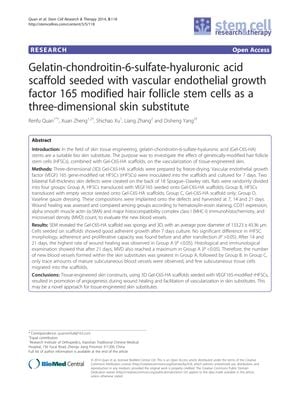TLDR Modified rat stem cells on a special scaffold improved blood vessel formation and wound healing in skin substitutes.
The study investigated the use of a three-dimensional gelatin-chondroitin-6-sulfate-hyaluronic acid (Gel-C6S-HA) scaffold combined with genetically-modified rat hair follicle stem cells (rHFSCs) to enhance vascularization in tissue-engineered skin. The rHFSCs were modified to express vascular endothelial growth factor (VEGF) 165 and seeded onto the scaffolds. Eighteen Sprague-Dawley rats with bilateral full-thickness skin defects were divided into four groups, with Group A receiving the VEGF165-modified rHFSCs on Gel-C6S-HA scaffolds. After 14 and 21 days, Group A showed the highest rate of wound healing and the maximum microvessel density (MVD), indicating the greatest formation of new blood vessels. The study concluded that tissue-engineered skin constructs using Gel-C6S-HA scaffolds seeded with VEGF165-modified rHFSCs significantly promoted angiogenesis and vascularization, suggesting a novel approach for skin substitutes.
24 citations
,
November 2013 in “Molecular Medicine Reports” Human hair follicle stem cells can become endothelial cells with certain growth factors, useful for vascular treatments.
19 citations
,
September 2013 in “Molecular Medicine Reports” Human hair follicle stem cells can become smooth muscle cells using specific growth factors.
201 citations
,
August 2006 in “Cell and Tissue Research” 344 citations
,
June 2006 in “American Journal Of Pathology” Human hair follicles can provide stem cells for regenerative medicine.
1010 citations
,
August 2000 in “Cell” Hair follicle stem cells can form both hair follicles and skin.
 26 citations
,
January 1994 in “Clinics in Dermatology”
26 citations
,
January 1994 in “Clinics in Dermatology” Artificial skin is improving wound healing and shows potential for treating different types of wounds.
 1 citations
,
May 2017 in “Asian journal of medical sciences”
1 citations
,
May 2017 in “Asian journal of medical sciences” The dietary supplement significantly improved skin, nails, and hair in older adults.
 18 citations
,
December 2018 in “Expert Opinion on Biological Therapy”
18 citations
,
December 2018 in “Expert Opinion on Biological Therapy” Hair follicle stem cells are promising for wound healing but require more research for safe clinical use.
9 citations
,
June 2019 in “Cell cycle/Cell cycle (Georgetown, Tex. Online)” A specific RNA increases hair stem cell growth and skin healing by affecting a protein through interaction with a microRNA.
December 2016 in “Chin J Anat Clin” Rat hair follicle stem cells can be effectively isolated and used for tissue engineering.
23 citations
,
May 2019 in “Stem cell research & therapy” iPSC-derived stem cells on a special membrane can help repair full-thickness skin defects.



